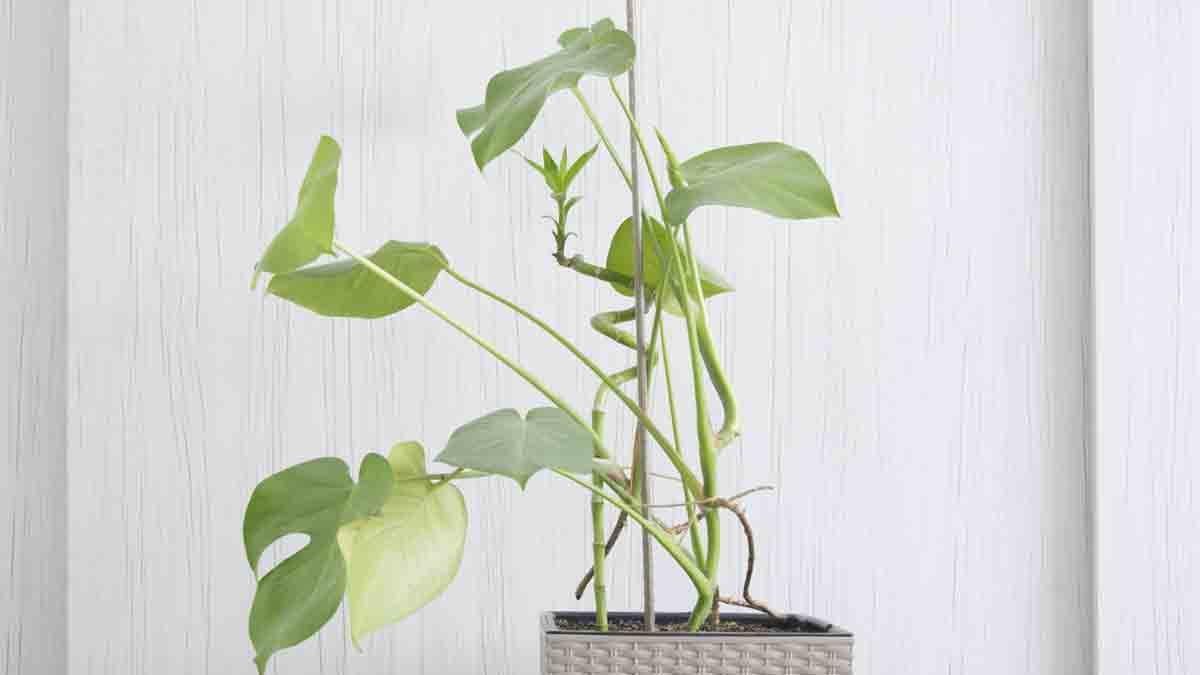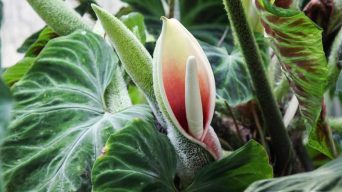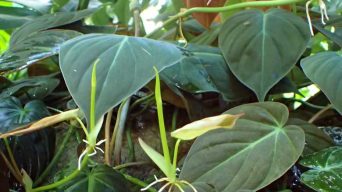Leggy philodendron plants result from insufficient light or overfertilization. To fix this, move to a brighter spot, prune, provide support, and avoid excessive fertilization. Prevent legginess with proper lighting, regular pruning, and careful fertilization. Keep your philodendron healthy and lush!
Philodendron plants are one of the most popular houseplants, for a good reason!
They’re easy to care for, thrive in various lighting conditions, and can even help purify the air in your home.
But even the most low-maintenance plant can have problems occasionally, and one common issue is leggy growth.
Leggy philodendron plants are usually the result of too little light, which causes the plant to stretch out in search of a sunny spot.
Fortunately, there’s an easy fix for this problem. Read on to learn how to fix a leggy philodendron and keep your plant looking its best.
What Causes a Philodendron to Become Leggy
There are a few reasons why your philodendron might become leggy. The most common cause is insufficient light.
Philodendrons prefer bright indirect sunlight, but if they’re not getting enough light, they will start to stretch out in search of a sunny spot.
They need at least four hours of indirect sunlight daily to prevent leggy growth.
Another cause of leggy philodendrons includes too much fertilizer, which can cause the plant to grow too quickly. High nitrogen levels, in particular, can cause leggy growth.
How To Tell If a Philodendron Is Leggy
A few signs will help you tell if your philodendron is leggy.
These signs include:
The Stems Are Long and Thin
In low light conditions, philodendron plants will stretch out in search of sunlight. This causes the stems to become long and thin.
If the plant is stretching towards the light, it’s a good indication that it’s not getting enough light.
The Leaves Are Small and Spaced Far Apart
Another sign of leggy growth is small leaves spaced far apart on the stem. This is because the plant uses more energy to grow taller than it produces leaves.
If there are few leaves and the stems are long, it’s a good indication that your philodendron is leggy.
The Plant Is Not Growing New Leaves
In general, philodendrons are fast-growing plants. If your plant is not growing new leaves, it’s a sign that something is wrong.
Leggy philodendron plants often stop growing new leaves because they use all their energy to grow taller.
The Plant Is Pale Green or Yellow
If your philodendron is pale green or yellow, it’s a sign that it’s not getting enough light.
In low light conditions, the leaves of a philodendron plant will lose their green color and start to turn yellow or pale green.
The Plant Is Falling Over
If your philodendron plant is falling over, it’s a sign that it’s not getting enough support.
Leggy plants are top-heavy and can fall over easily if they’re not supported. You might see the plant leaning to one side or toppling over entirely.
The Plant Looks Weak and Spindly
If your philodendron plant looks weak and spindly, it’s a sign that it’s not getting enough light.
In low light conditions, the plant will become leggy and unable to support itself. The leaves will also be small and spaced far apart on the stem.
How to Fix a Leggy Philodendron
Now that you know how to tell if your philodendron is leggy, it’s time to learn how to fix it.
The good news is that leggy growth is easy to fix, and your plant will quickly bounce back with the proper care.
Here are a few simple tips for fixing a leggy philodendron:
Move Your Plant to a Brighter Location
If your philodendron is leggy, you should first move it to a brighter location.
Philodendrons prefer bright indirect light, so try to find a spot that gets at least four hours of sunlight daily.
East- or west-facing windows are ideal. This will give your plant the bright light it needs without exposing it to direct sunlight, which can scorch the leaves.
When grown outdoors, philodendrons prefer shady locations. They will also do well in containers that are placed in dappled sunlight.
If you can’t provide enough bright light, you can also try using grow lights. These specially designed lights mimic sunlight and help your plant grow.
Prune Your Plant
Pruning is a great way to fix leggy growth and encourage your philodendron to branch out.
To prune your philodendron, cut off the leggy stems at the desired length. You can also remove any leaves that are yellow or brown.
Be sure to use sharp, clean shears and make clean cuts just above a leaf node. This is where new leaves will grow, so it’s the ideal spot for pruning.
After you’ve pruned your plant, it’s essential to give it time to recover. Avoid fertilizing or watering for a week or two to prevent stress on the plant.
Once the plant has had a chance to recover, you can resume regular care.
Provide Support for Your Plant
If your philodendron is leggy and falling over, it’s essential to provide support.
You can do this by staking the plant or placing it in a pot with a trellis. This will help the plant grow upright and prevent it from falling over.
You can also try wrapping the plant’s stem around a support, such as a bamboo stake. Be sure to do this gently, so you don’t damage the stem.
Stop Overfertilizing Your Plant
If you’re overfertilizing your philodendron, it can cause leggy growth.
Philodendrons don’t need a lot of fertilizer, so be sure to follow the directions on the fertilizer package.
Stop fertilizing altogether if you suspect that it’s causing leggy growth. Your plant will be fine without it and will eventually bounce back.
You can also flush the soil to remove the excess fertilizer. To do this, water the plant until the water runs out of the pot and drains away.
Repot Your Plant in Fresh Soil
If your plant has been overfertilized, you might need to repot it in fresh soil.
To do this, remove the plant from its pot and discard the old soil. Be sure to wash the pot before replanting the philodendron in fresh soil.
To improve drainage, you can also add some perlite or sand to the new soil. This will help prevent the roots from sitting in water, which can lead to problems.
How to Prune a Leggy Philodendron (Step-by-Step Guide)
If your philodendron has become leggy, don’t worry – you can quickly fix the problem with a bit of pruning.
Follow these simple steps, and your philodendron will soon look lush and full again.
- Start by removing any dying or dead leaves from your plant. These can be found at the bottom of the stem, near the soil.
- Cut off any leggy, bare stems about an inch above a leaf node. These are the points on the stem where leaves emerge.
- Next, cut the stem of your plant back by about a third. This will encourage new growth and make your philodendron fuller.
- Once you have removed all the leggy stems, look at the remaining leaves. If any of them are yellowing or browning, it’s best to remove them too.
- Finally, give your plant a good watering and place it in a bright spot. With a bit of love and care, your philodendron will soon be looking as good as new!
Pruning your philodendron is a great way to keep it looking full and healthy.
Following these simple steps, you can quickly transform your leggy plant into a lush, full-grown philodendron.
How To Prevent Leggy Growth in Your Philodendron
You can do a few simple things to prevent leggy growth in your philodendron.
Here are a few tips:
Give Your Plant Enough Light
Philodendrons need bright indirect light to thrive. If your plant is not getting enough light, it will become leggy in an attempt to reach the light source.
Place your plant in a spot where it will get plenty of light, but avoid direct sunlight, which can scorch the leaves.
Turn Your Plant Regularly
Another way to prevent leggy growth is to turn your plant regularly. This will ensure that all sides of the plant get an equal amount of light.
If you notice that one side of your plant is starting to stretch, turn the pot so that the other side is facing the light source.
Prune Your Plant Regularly
Pruning your plant regularly will also help to prevent leggy growth.
As your plant grows, be sure to remove any dead or dying leaves, as well as any leggy, bare stems.
By pruning your plant regularly, you will encourage new growth and keep your philodendron looking full and healthy.
You can easily prevent leggy growth in your philodendron with love and care. Following these simple tips, you can keep your plant looking lush and full for years.
Don’t OverFertilize Your Plant
One of the most common causes of leggy growth is overfertilization.
When you fertilize your plant, you give it an energy boost. This can cause the plant to produce more leaves and grow taller.
If you notice that your plant is starting to stretch, it’s a good idea to cut back on the fertilizer.
Only fertilize your plant when it is actively growing, and use a half-strength solution. This will help prevent leggy growth and keep your plant looking its best.
Final Thoughts
Philodendron plant care is not complex, although it can sometimes be a bit fussy.
The key to success is paying attention to your plant and understanding its needs.
With a little effort, you can have a healthy and happy philodendron that will thrive for many years.







